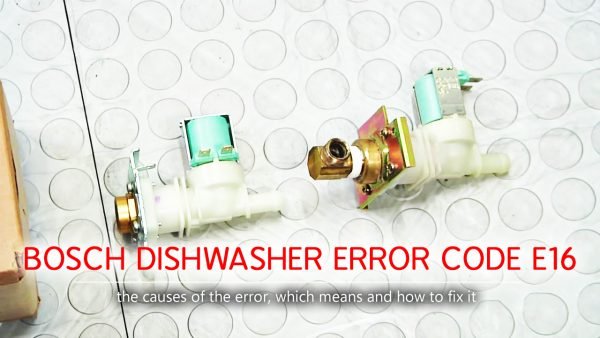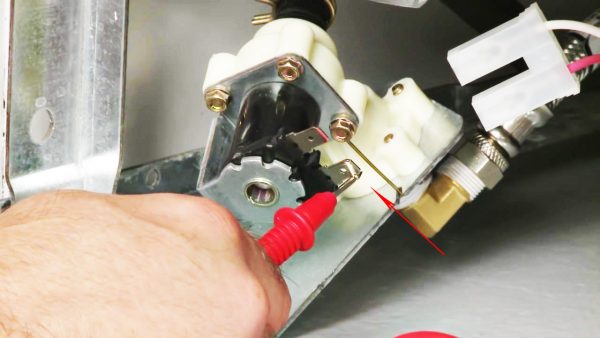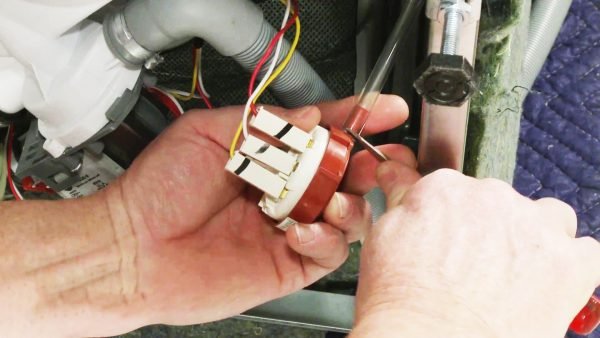The E16 error in Bosch dishwasher means that unscheduled water set has occurred. When the Bosch dishwasher shows the E16 error, it signals that the device can’t block the water flow into the tank. Therefore, the water continues to enter uncontrollably. Most likely, there is a problem with the intake valve, which can not close completely due to clogging.
What to do when the E16 error of the Bosch dishwasher occurs:
- Check and clean the fill valve.
- Check the water level sensor. The test should be carried out only after draining the water and before switching off the machine.
- If the error appears during the washing program, there is a possibility that excessive foaming has become the cause.
If you carry out all the above actions but the error remains, do not postpone the call to a specialist.
Check the water supply. Is there any water in the plumbing? Is the water tap in front of the dishwasher closed? Inspect the filter of a water inlet hose for bending, squashing, twisting, etc. Be sure to examine it for clogging.
How To Check The Intake Valve?
The intake valve is very important. It blocks the water, which comes into the dishwasher under pressure. It opens for a specific period of time following the control module command. It pumps some water and gets a command to close again. Activation of the valve occurs when a dishwasher needs more clean water. Depending on the program, the appliance requires it from 2 to 8 times per wash cycle.
Malfunction of the control module or the wiring connecting the control board and the inlet valve will lead to the dysfunction of the last one.
The intake valve and the control module connection allows to quickly shut off the water. It is required not only in normal operating conditions but also in emergency situations. Although there is a special valve is the dishwasher for accidents.
If during water gaining your dishwasher pours out or does not fill the water at all, the cause may be a defective water supply valve. An electrical or mechanical part may be faulty in the valve. To determine the serviceability of the electrical part of the valve, you must check the resistance of the valve coil. It is important to find out whether it is intact or not. If the multimeter shows the resistance of the valve coil from 500 to 1500 ohms, then the valve coil is OK.
The detection of mechanical valve defects can be more complicated. If the tank is very slowly filled with water, then probably the filling valve is clogged. In this case, simply replace the valve. Trying to clean the old valve is not recommended.
The overflow of water in the tank is a sign that the valve may be stuck in the open position. One of the ways to determine this is to open the dishwasher door several times during the water fill cycle. If the water continues to flow into the tank, with the door open, the water fill valve is defective. You have to replace the part.
If the dishwasher tank is not filled at all, first you have to make sure that the water tap is turned on. Also, there must be enough water pressure in the washer.
Next, make sure that the float can move freely up and down. In addition, you have to hear the click sound from the float switch. If no clicks are heard, you should check the resistance of the contacts of the float switch. If the switch is in order, the most likely cause of water shortage is the faulty filling valve.
How To Fix Water Filling Valve
If the dishwasher does not fill water:
- Make sure that the water supply to the dishwasher is connected.
- Check the timer to make sure it works consistently and correctly. If both the water supply and the timer are in order, most likely the problem relates to the intake valve.
- Check the inlet valve located under the dishwasher tank. Malfunctions of the inlet valve can arise due to fine particles, coming from plumbing. To solve this problem, remove the valve filter with a screwdriver. Next, rinse it thoroughly under running water. Then set to the same place and check the water supply.
- If the valve is controlled by a solenoid, press it with a screwdriver to make sure that everything is in order.
- If the dishwasher is still not filled with water, check the solenoid with a volt-ohm-milliammeter (VOM). If the instrument reading is approximately 100 ohms to 1000 ohms, the solenoid works. If the values are higher than 1000, the solenoid is defective. You have to replace it.
- If necessary, replace the solenoid with a new one of the same size and type. Connect the new solenoid valve, just as the replaced one was connected.
How To Check The Intake Pressure Switch?
The main task of the pressure switch of any Bosch dishwasher is to maintain a certain level of water in the chamber. If the pressure switch is defective, it is likely that the working chamber of the machine will be full of water.
You can diagnose the breakdown through the observation of water. It is located in the chamber of the dishwasher. If the difference with the norm is very high, then, most likely, the sensor is defective. Typically, when a water level sensor breaks down.
There are two types of pressure switch:
- Mechanical sensor;
- Electronic sensor.
The mechanical pressure switch can be checked aurally. This way, you can identify a malfunction. The part’s work should be accompanied by characteristic clicks. For this, it is enough to know its approximate location and carefully listen to the technique. But the malfunction of the electronic sensor is impossible to find this way.
How to replace the sensor in the dishwasher?
The procedure is as follows:
- First, you need to carefully remove the back panel on the dishwasher.
- Then remove the pressure hose, located under the pressure switch.
- Disconnect the unit from its place.
- The connector is also pulled out.
- Perform the assembly of the new sensor in the reverse order.
Once the new part is installed, it is necessary to check the correctness of its installation. To do this, run the test start of the dishwasher. If everything is done correctly, the water level in the unit will be optimal.



